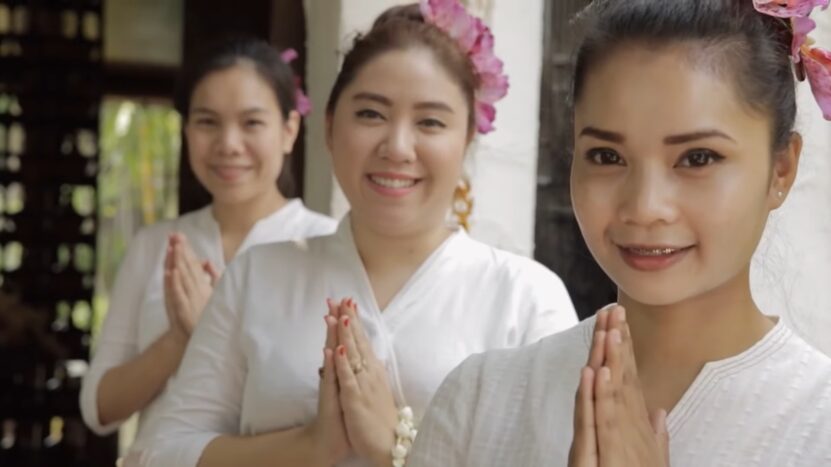“Long before you ever heard of Thailand, you probably heard that it takes more muscles to frown than it does to smile, suggesting that you’re better off using your physiognomy to smile. In reality, it takes 12 to smile and 11 to frown. Had the Tourism Authority of Thailand realized years ago that frowning was easier, they may have promoted Thailand as the Land of Frowns. ”
Welcome to the Land of Smiles. When you come to Thailand, when you visit forums about Thailand, you constantly see this term bandied about. You’ll often notice the nation abbreviated as LoS. Some people attribute the moniker to Thai people always being in a good mood.
Others, to the endless supply of foreign senior citizens in Pattaya with smiles of bliss glued to their faces after being satisfied simultaneously by two slender Thai teenagers.
The real Land of Smiles should be Norway. They have a womb-to-tomb welfare state, one of the highest GDP per capita in the world, ample natural resources and land spread among just 5m people, and freedom from the governmental bureaucracy called the European Union.
But well, Norway never grabbed the name, and it may have not been fair either. Tourists visiting Norway and experiencing its sky-high prices and eternal darkness during the winter are more often crying than smiling.
Thailand is called the Land of Smiles because the Thais really do smile a lot, but let it be known that not all these “smiles,” called yim in Thai, are what the foreigner would normally define as a smile.
The Thais have a wide range of terms for different types of smiles, thirteen to be exact. They’re like the Eskimos with all their different terms for snow. Most of these smiles do not signify that the Thai person is in a beaming good mood.
Types of Smiles

Foreigners to Thailand may carry a phrase book. They point to a phrase in Thai and show that to the Thai to make themselves understand. When a Thai smiles at you, point to the following list of smiles and ask him or her which smile they’re conveying. You’ll then know if they’re smiling back or if you should start running.
Once you become accustomed to what each smile means, you can flash the same ‘smiles’ back at the Thais. No practice is required to perform any of these smiles. Chances are you already put your facial muscles in these positions on a regular basis. We just have the sense not to call these facial gestures smiles and then market our countries with them.
| Type | When To Use |
| The smile of hopelessness. The situation is so bleak, you’ve got nothing better to do but offer a pathetic smile. Example: you’ve just been mugged, and had your passport and money stolen, and your Embassy won’t bother making a phone call on your behalf except at super expensive direct dial rates. | |
| The polite smile. Example: you’ve just met four strangers who are sure to bore you to tears with stories about the size of corn ears, but you have to smile, shake their hands, and say it was great to meet them. | |
| The nervous apologetic smile. Example: you accidentally put vodka instead of Sprite in 9-year-old Junior’s glass. Junior drank it … eagerly .. and is now vomiting, and your wife is accusing you of trying to turn Junior into an alcoholic. | |
| The forced smile. Example: the corrupt and evil mayor of town wins the next major election. Your parents are good friends of this crook, so you have to attend his victory party to congratulate him. | |
| The smile of diffusion, to get past embarrassing and awkward situations. Example: you’ve just been elected the new corrupt mayor of your town, and your 20-year-old daughter emerges drunken and nude at your congratulatory dinner to call you a crook. | |
| The inappropriate hidden smile. You want to smile but it’s inappropriate to do so. Example: Your cruel live-in mother-in-law just died, and your wife is in tears. You feel like you got a new lease on life but you can’t act glad about the news in front of her. | |
| The victory smile. Example: You’re Harry Potter and you just beat Draco Malfoy’s team at Quidditch. | |
| The admiration smile. Example: you’re part of an evil terrorist cell and your leader has just suggested what everyone feels is a brilliant plan to blow up an entire country of innocent people. | |
| The happy smile. The smile you expect to see on someone’s face in light of good news. Example: you’ve just approached two dream women at a bar, boldly suggested a threesome, and they both agreed to it! | |
| The evil smile. Example: how a used car salesman would look just before he’s about to overcharge you on the lemon you’re going to buy from him. | |
| The attitude smiles. When you have the attitude you’re right and everyone else is wrong. Example: Tom Cruise’s rants on The Today Show about psychiatry bordering on pseudoscience | |
| The mocking smile. Example: you’re in the audience of The Today Show or The Oprah Winfrey Show as Tom Cruise goes on his embarrassing rants. You smile at him and shout in humor, “You tell ’em, Tom!” | |
| The sad smile. You’re feeling tremendously sad but must cover it up. Example: Tom Cruise is your favorite actor, you’ve worshipped him for two decades, and now you’ve just painfully watched your idol make a fool of himself on The Today Show just before a dozen guests show up at your house for a dinner party you’re hosting. |
Final Words

In the intricate dance of human emotions, smiles take center stage. From the bustling streets of Bangkok to the icy fjords of Norway, our facial expressions convey an array of sentiments, often transcending the barriers of language.
Thailand labeled the “Land of Smiles,” invites visitors not only to revel in its natural beauty and cultural treasures but also to decipher the subtleties behind each “Yim.” While some smiles radiate genuine happiness, others may veil sadness, anxiety, or even mischief.
As travelers, it’s our privilege and challenge to understand and appreciate these nuances. So, the next time you’re greeted with a smile, be it in the alleys of Pattaya or the fjords of Norway, pause for a moment.
Recognize the emotion, reciprocate with understanding, and immerse yourself in the shared human experience. Because in a world filled with myriad expressions, a smile remains the universal language of connection.
